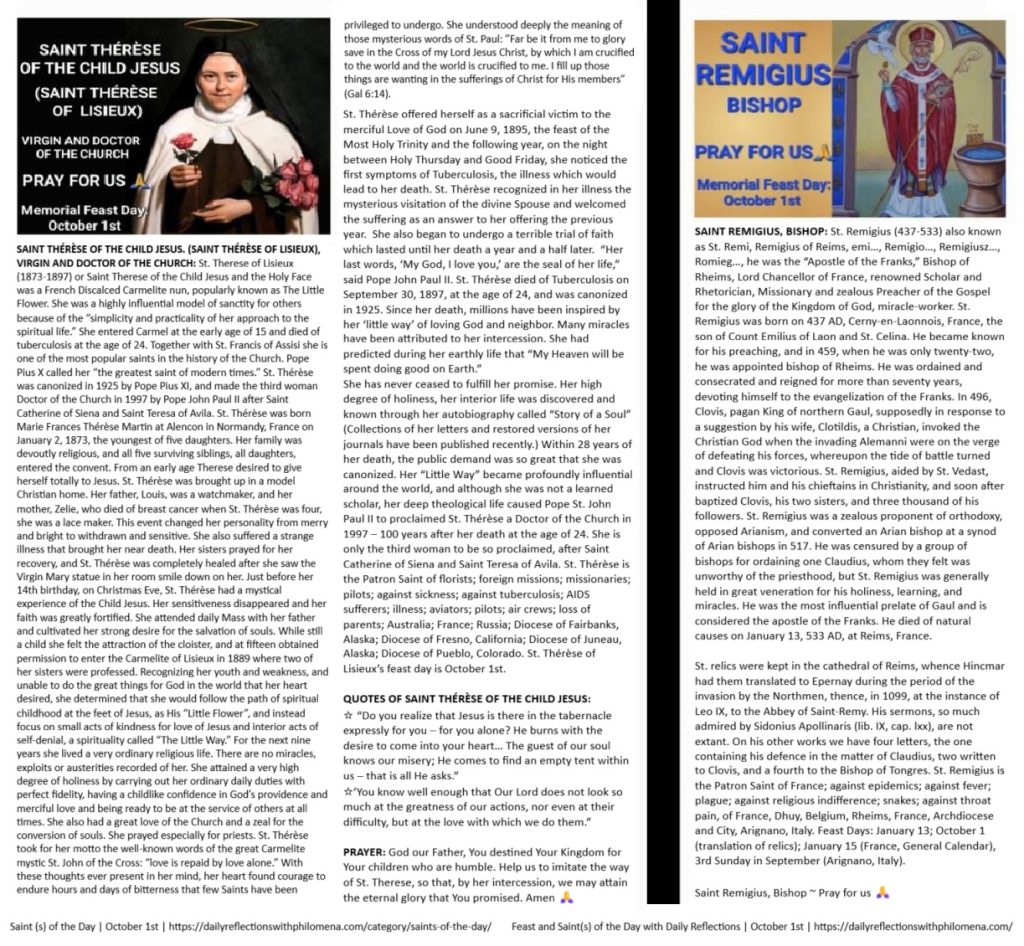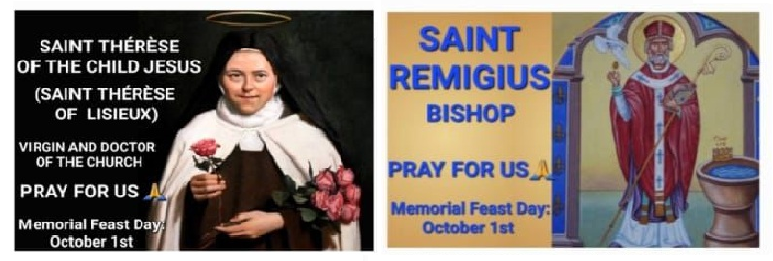
MEMORIAL OF SAINT THÉRÈSE OF THE CHILD JESUS (SAINT THÉRÈSE OF LISIEUX), VIRGIN AND DOCTOR OF THE CHURCH AND SAINT REMIGIUS, BISHOP – FEAST DAY ~ OCTOBER 1ST: Today, we celebrate the Memorial of Saint Thérèse of the Child Jesus (St. Thérèse of Lisieux), Virgin and Doctor of the Church and Saint Remigius, Bishop. Through the intercession of our Blessed Mother Mary and the Saints on this feast day, we humbly pray for the safety and well-being of all missionaries, pilots and all travelers. We pray for the sick and dying, especially those who are sick with the coronavirus, mental illness, HIV/AIDS, tuberculosis, throat diseases and those suffering from cancers and other terminal diseases. We pray for the souls in Purgatory and the repose of the souls of the faithful departed. We pray for all widows and widowers. We pray for the poor and needy, for peace, love, and unity in our marriages, our families and our world. And we continue to pray for our Holy Father, Pope Leo XIV the Bishops, the Clergy, for vocations to the priesthood and religious life, for the Church, for persecuted christians, for the conversion of sinners, and Christians all over the world… Amen🙏
SAINT THÉRÈSE OF THE CHILD JESUS. (SAINT THÉRÈSE OF LISIEUX), VIRGIN AND DOCTOR OF THE CHURCH: St. Therese of Lisieux (1873-1897) or Saint Therese of the Child Jesus and the Holy Face was a French Discalced Carmelite nun, popularly known as The Little Flower. She was a highly influential model of sanctity for others because of the “simplicity and practicality of her approach to the spiritual life.” She entered Carmel at the early age of 15 and died of tuberculosis at the age of 24. Together with St. Francis of Assisi she is one of the most popular saints in the history of the Church. Pope Pius X called her “the greatest saint of modern times.” St. Thérèse was canonized in 1925 by Pope Pius XI, and made the third woman Doctor of the Church in 1997 by Pope John Paul II after Saint Catherine of Siena and Saint Teresa of Avila. St. Thérèse was born Marie Frances Thérèse Martin at Alencon in Normandy, France on January 2, 1873, the youngest of five daughters. Her family was devoutly religious, and all five surviving siblings, all daughters, entered the convent. From an early age Therese desired to give herself totally to Jesus. St. Thérèse was brought up in a model Christian home. Her father, Louis, was a watchmaker, and her mother, Zelie, who died of breast cancer when St. Thérèse was four, she was a lace maker. This event changed her personality from merry and bright to withdrawn and sensitive. She also suffered a strange illness that brought her near death. Her sisters prayed for her recovery, and St. Thérèse was completely healed after she saw the Virgin Mary statue in her room smile down on her. Just before her 14th birthday, on Christmas Eve, St. Thérèse had a mystical experience of the Child Jesus. Her sensitiveness disappeared and her faith was greatly fortified. She attended daily Mass with her father and cultivated her strong desire for the salvation of souls. While still a child she felt the attraction of the cloister, and at fifteen obtained permission to enter the Carmelite of Lisieux in 1889 where two of her sisters were professed. Recognizing her youth and weakness, and unable to do the great things for God in the world that her heart desired, she determined that she would follow the path of spiritual childhood at the feet of Jesus, as His “Little Flower”, and instead focus on small acts of kindness for love of Jesus and interior acts of self-denial, a spirituality called “The Little Way.” For the next nine years she lived a very ordinary religious life. There are no miracles, exploits or austerities recorded of her. She attained a very high degree of holiness by carrying out her ordinary daily duties with perfect fidelity, having a childlike confidence in God’s providence and merciful love and being ready to be at the service of others at all times. She also had a great love of the Church and a zeal for the conversion of souls. She prayed especially for priests. St. Thérèse took for her motto the well-known words of the great Carmelite mystic St. John of the Cross: “love is repaid by love alone.” With these thoughts ever present in her mind, her heart found courage to endure hours and days of bitterness that few Saints have been privileged to undergo. She understood deeply the meaning of those mysterious words of St. Paul: ”Far be it from me to glory save in the Cross of my Lord Jesus Christ, by which I am crucified to the world and the world is crucified to me. I fill up those things are wanting in the sufferings of Christ for His members” (Gal 6:14).
St. Thérèse offered herself as a sacrificial victim to the merciful Love of God on June 9, 1895, the feast of the Most Holy Trinity and the following year, on the night between Holy Thursday and Good Friday, she noticed the first symptoms of Tuberculosis, the illness which would lead to her death. St. Thérèse recognized in her illness the mysterious visitation of the divine Spouse and welcomed the suffering as an answer to her offering the previous year. She also began to undergo a terrible trial of faith which lasted until her death a year and a half later. “Her last words, ‘My God, I love you,’ are the seal of her life,” said Pope John Paul II. St. Thérèse died of Tuberculosis on September 30, 1897, at the age of 24, and was canonized in 1925. Since her death, millions have been inspired by her ‘little way’ of loving God and neighbor. Many miracles have been attributed to her intercession. She had predicted during her earthly life that “My Heaven will be spent doing good on Earth.”
She has never ceased to fulfill her promise. Her high degree of holiness, her interior life was discovered and known through her autobiography called “Story of a Soul” (Collections of her letters and restored versions of her journals have been published recently.) Within 28 years of her death, the public demand was so great that she was canonized. Her “Little Way” became profoundly influential around the world, and although she was not a learned scholar, her deep theological life caused Pope St. John Paul II to proclaimed St. Thérèse a Doctor of the Church in 1997 – 100 years after her death at the age of 24. She is only the third woman to be so proclaimed, after Saint Catherine of Siena and Saint Teresa of Avila. St. Thérèse is the Patron Saint of florists; foreign missions; missionaries; pilots; against sickness; against tuberculosis; AIDS sufferers; illness; aviators; pilots; air crews; loss of parents; Australia; France; Russia; Diocese of Fairbanks, Alaska; Diocese of Fresno, California; Diocese of Juneau, Alaska; Diocese of Pueblo, Colorado. St. Thérèse of Lisieux’s feast day is October 1st.
QUOTES OF SAINT THÉRÈSE OF THE CHILD JESUS:
☆ “Do you realize that Jesus is there in the tabernacle expressly for you – for you alone? He burns with the desire to come into your heart… The guest of our soul knows our misery; He comes to find an empty tent within us – that is all He asks.”
☆’You know well enough that Our Lord does not look so much at the greatness of our actions, nor even at their difficulty, but at the love with which we do them.”
PRAYER: God our Father, You destined Your Kingdom for Your children who are humble. Help us to imitate the way of St. Therese, so that, by her intercession, we may attain the eternal glory that You promised. Amen 🙏
SAINT REMIGIUS, BISHOP: St. Remigius (437-533) also known as St. Remi, Remigius of Reims, emi…, Remigio…, Remigiusz…, Romieg…, he was the “Apostle of the Franks,” Bishop of Rheims, Lord Chancellor of France, renowned Scholar and Rhetorician, Missionary and zealous Preacher of the Gospel for the glory of the Kingdom of God, miracle-worker. St. Remigius was born on 437 AD, Cerny-en-Laonnois, France, the son of Count Emilius of Laon and St. Celina. He became known for his preaching, and in 459, when he was only twenty-two, he was appointed bishop of Rheims. He was ordained and consecrated and reigned for more than seventy years, devoting himself to the evangelization of the Franks. In 496, Clovis, pagan King of northern Gaul, supposedly in response to a suggestion by his wife, Clotildis, a Christian, invoked the Christian God when the invading Alemanni were on the verge of defeating his forces, whereupon the tide of battle turned and Clovis was victorious. St. Remigius, aided by St. Vedast, instructed him and his chieftains in Christianity, and soon after baptized Clovis, his two sisters, and three thousand of his followers. St. Remigius was a zealous proponent of orthodoxy, opposed Arianism, and converted an Arian bishop at a synod of Arian bishops in 517. He was censured by a group of bishops for ordaining one Claudius, whom they felt was unworthy of the priesthood, but St. Remigius was generally held in great veneration for his holiness, learning, and miracles. He was the most influential prelate of Gaul and is considered the apostle of the Franks. He died of natural causes on January 13, 533 AD, at Reims, France.
St. relics were kept in the cathedral of Reims, whence Hincmar had them translated to Epernay during the period of the invasion by the Northmen, thence, in 1099, at the instance of Leo IX, to the Abbey of Saint-Remy. His sermons, so much admired by Sidonius Apollinaris (lib. IX, cap. lxx), are not extant. On his other works we have four letters, the one containing his defence in the matter of Claudius, two written to Clovis, and a fourth to the Bishop of Tongres. St. Remigius is the Patron Saint of France; against epidemics; against fever; plague; against religious indifference; snakes; against throat pain, of France, Dhuy, Belgium, Rheims, France, Archdiocese and City, Arignano, Italy. Feast Days: January 13; October 1 (translation of relics); January 15 (France, General Calendar), 3rd Sunday in September (Arignano, Italy).
Saint Remigius, Bishop ~ Pray for us 🙏
